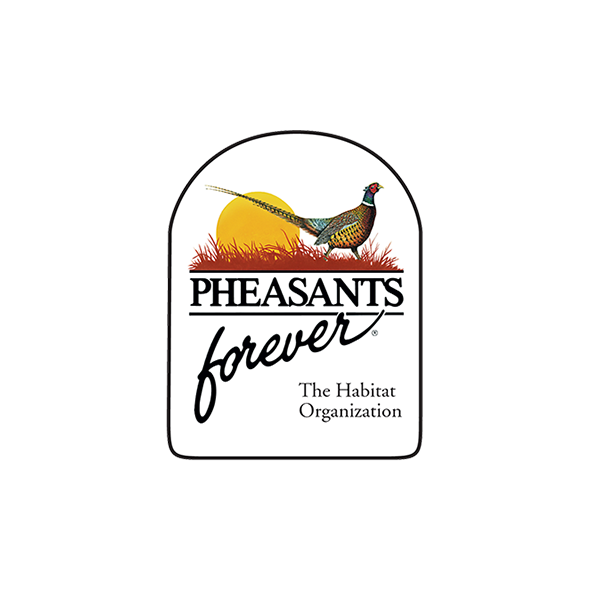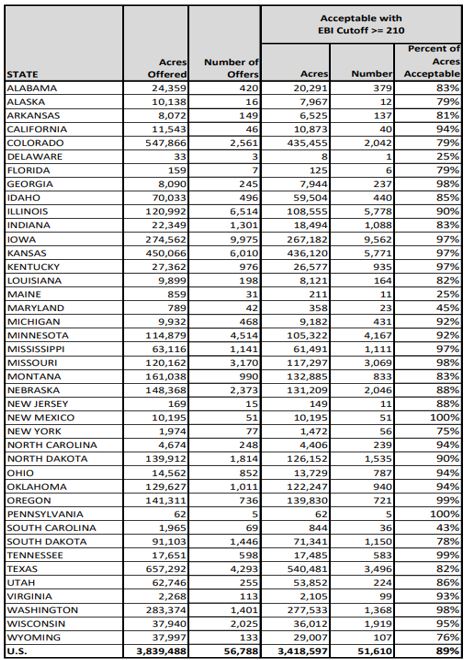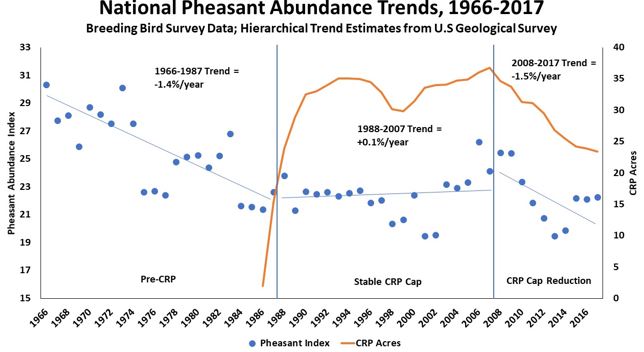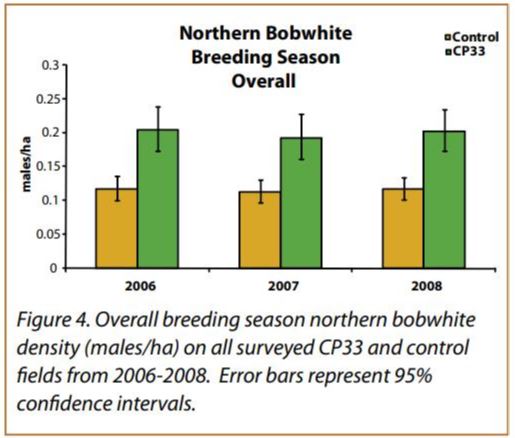Digging into CRP’S New 3.4 Million Acres

Spring’s Conservation Reserve Program (CRP) signup is in the books. Here are the results, and what they mean for your state and favorite hunting spots:
The United States Department of Agriculture (USDA) has announced results from the latest CRP general signup. Pheasants Forever offered an initial response on the day of release. We are thankful for the farmers, ranchers and landowners that voluntarily enrolled in one of the best private land conservation programs in the country!
CRP INSIGHTS AND BENEFITS
With CRP, landowners can enroll in practices that improve wildlife habitat, reduce soil erosion from water and/or wind), and improve water quality, all while keeping working lands productive and efficient.
The general CRP signup is a competitive process in which the USDA selects lands to enroll, using the Environmental Benefits Index (EBI). Each CRP offer is scored under the EBI, which ranks on the basis of location and the amount of conservation benefits it will provide.
Conservation is a major piece of the Farm Bill and certainly part of the overall economic and ecological safety net, especially in extreme weather events as well as disasters such as floods, drought and fires. CRP and other Farm Bill Conservation programs also provide an economic boost to rural areas in autumn when hotels, gas stations, convenience stores, sport shops, restaurants and fields are full of hunters pursuing their favorite game. Landowners should be fairly compensated for installing these voluntary practices that benefit all of society, be it in rural, suburban and urban areas throughout the country.
As PF members and supporters, you recognize that pheasants, quail and numerous other wildlife species — from pollinators and songbirds to waterfowl and big game — benefit from the habitat that is provided from CRP.
I’d bet that if you have spent any time in CRP, you might have even grabbed a handful of berries while running your dog or scouting out a new hunting area in mid-summer. Maybe you benefit from honeybees visiting a CRP wildflower patch, or appreciate seeing the monarch butterfly as you enjoy the outdoors. CRP also reduces soil erosion from water and wind, as well as improved water quality that benefit inland and coastal fisheries, and certainly the quality of water coming out of your tap.
For these reasons and many more, the Farm Bill conservation programs like CRP are a top priority for the Habitat Organization.
Delivering conservation programs is a team and partner effort, and we couldn’t do it without the support from Congress making conservation a priority, or USDA staff for implementing the programs at the county level. We depend on our grassroots support from our PF members, volunteers and supporters in our local communities across the Country. PF is also proud to work with our State wildlife and natural resources agencies and other partners to help deliver conservation programs to landowners across the country.
CRP BY THE NUMBERS
Recall from some of our previous blogs and articles that Congress set the cap at 27 million acres by 2023. That means we have more opportunities to enroll acres before the 2018 Farm Bill authorization ends in September 2023.
The latest Farm Service Agency (FSA) report shows nationwide enrollment at 21.95 million acres, which is 2.55 million acres under the current 24.5 million acre cap authorized for 2020. In addition, 5.4 million acres of CRP are expiring Oct 1. With the new 3.4 million acres announced last week, that still leaves us with 4.6 million acres open for enrollment.
We have serious concerns that these 4.6 million acres are going to be difficult to enroll by Oct 1t, the start of the Federal FY2021 Fiscal Year. There are still opportunities to enroll Continuous CRP (CCRP) practices, as well as the Grassland CRP, the new Soil Health and Income Protection Program (SHIPP), and the soon-to-be-announced Clean Lakes Estuaries and Rivers (CLEAR30) program.
Here’s a summary of all that:
• 22.95 million acres – Current CRP enrollment (as of end of January 2020)
• 5.4 million acres – Expiring on Oct 1 2020
• 3.4 million acres – New 10-15-year contracts announced by USDA March 26
• 4.5 to 5 million acres – Additional acres needed to meet Congressional enrollment targets in 2020
• 27 million acres – 2018 Farm Bill acreage target by 2023
A GOOD ACCEPTANCE RATE
The good news is that 3.8 million acres were offered and 3.4 million acres were accepted, resulting in an 89% acceptance rate (Figure 1 below). This is certainly better than the numbers we got 4 years ago when the last general signup only offered 400,000 acres and had but a 20% acceptance rate. This is also a good start to meeting the CRP enrollment goals that Congress put in place under the 2018 Farm Bill.
Figure 1 shows the number of offers and accepted contracts and acres. Texas, Colorado and Kansas took the top 3 spots, and have always produced a large number of CRP contracts and acres. These areas are known to produce pheasants, bobwhite quail and a few scaled quail, along with the suite of other upland birds.
We also saw strong enrollment numbers in other pheasant and quail states: Illinois, Iowa. Idaho, Minnesota, Missouri, Montana, Nebraska, North Dakota, South Dakota, Oregon and Washington. All these states generally do well in a general CRP sign up and put up big numbers of acres. It should be noted that these and other states also have the opportunity to enroll more acres through the Continuous CRP signup and other programs mentioned above.
We should also note that you may likely see some of these CRP acres open through state walk-in access programs such as funding offed in the Farm Bill, Voluntary Public Access- Habitat Improvement Program (VPA-HIP).
FIGURE 1: 2020 CRP SIGNUP ANALYSIS

Figure 1. USDA state-by-state CRP offers and accepted acres from the CRP54 sign up December 9 2019 – February 28 2020.
IS IT ENOUGH?
CRP benefits for wildlife have been well documented over the last 30 years, and it is well demonstrated, and you certainly know as a hunter, that pheasant and quail populations flourish when quality habitat is available. The US Geological Survey (USGS) has been conducting wildlife population surveys since 1966.
Pheasants have been one species on that list. There are 50 survey points conducted along predetermined routes that basically haven’t changed in more than 50 years. It clearly demonstrates that there was a period of about 20 years (1988-2017) where pheasant populations were stable, and actually increased slightly.
If you were pheasant hunting during 2006-2010, you most likely experienced some of the best hunting in modern times. We can then see the population decline that began around 2009 when the CRP demand and acreage decreased. In fact, being that we are currently at 21.95 million acres really puts us back to the enrollment we observed in 1988 when we had about 20 million acres enrolled nationwide.
You may also have been quail hunting the last couple of years and experienced near lifetime population highs. The reason we experienced this regionally is because of favorable weather conditions that lined up with great wildlife habitat in some of the bobwhite range. We will be publishing another article that will look only at bobwhite quail.
But it is not just pheasants and quail that have declined in the last 50 years. Last year researchers documented that we’ve lost 3 billion birds of multiple species. Grassland birds have declined the most. But waterfowl and wetland-dependent birds have actually increased in many regions. Why? Because we created the habitat!
All these habitat acres are certainly positive, and it is another step to getting the full enrollment. However as outlined above, there are still at a minimum, about 4.5 million more CRP acres that need to be enrolled yet this year. In addition, another 10 million acres will need enrollment by the spring of 2023 to keep pace with the 27 million acre goal by the end of the 2018 Farm Bill authorization.
BEYOND THE NUMBERS
Beyond the numbers of this signup, we remain concerned about the consequences of reduced rental rates and cost-share payments, and how these factors are influencing landowner decisions to participate in CRP. Regionally, we will continue to gather information about how these changes may be negatively influencing overall enrollment into conservation programs.
These questions have come up with the changes to the CRP language in the 2018 Farm Bill, but more so with the administrative changes to how rental rates and cost share are calculated for the annual payments, seed, establishment, and removal of mid-contract management cost-share. We continue to evaluate options to ensure landowners are getting the full benefit of what PF, other organizations and Congress supported in passing the 2018 Farm Bill.
FIGURE 2 – PHEASANT ABUNDANCE TRENDS

Figure 2. The US Geological Survey (USGS) has conducted bird surveys since 1966, it is the longest running dataset we have available that is standardized nationwide. The Pheasant Abundance Index represents the number of pheasants heard and seen along a typical standardize route within the national pheasant range in early June. This figure also overlays historic CRP acres with the survey to show CRP’s impact on pheasant populations. Other state by state pheasant population information can be found here.
FIGURE 3 – NORTHERN BOBWHITE AND CRP

Figure 3. Example of Bobwhite Quail response to CRP “Quail Buffers” (CP33 practice) from research conducted during 2006-2008 in multiple states. Field borders in an agriculture landscape result in high quality habitat that quail and other grassland birds utilize for nesting, brood rearing, foraging and winter cover. The results of this research can be found here.
FIGURE 4 – CP33 AND NORTHERN BOBWHITE BREEDING SUCCESS

WHAT CAN WE ALL DO?
First of all, the decline in any wildlife population is certainly troublesome, but we also know how to reverse that trend. Just look closely at the story the above graphs portray. During the 20-year period from 1990 to 2010, CRP was relatively stable at above 30 million CRP acres enrolled … and many states reported at or near-record pheasant and hunter levels.
The answer to the last decade’s decline in bird: Create Habitat! Just like the case of wetlands and waterfowl, North America’s focus on restoring and enhancing wetlands has increased populations to nearly historic highs. We have also brought back both game and non-game wildlife species from the brink of extinction. The takeaway here is that we have millions of acres of enrollment and restoration in our habitat toolbox, in the Farm Bill alone we have $30 BILLION that can create and enhance 10s of millions of acres as part of the 2018 Farm Bill.
If you happen to have some land that you would like to dedicate to conservation and wildlife, look at these options that will compensate you to enroll. Maybe it’s a piece of ground that is difficult to farm, it’s a wet spot in a field, or an area next to a stream that often floods, or perhaps a low-yielding edge along a woods or hedgerow. It could be a quarter section of land that is highly erodible.
There are numerous resources and individuals that are more than willing to walk you through some options. If you have a family member, friend or neighbor that has land that might qualify, let them know there are options to enroll, and good chance they will get in.
MORE TO COME
This post is one of several we will do as we look at how conservation policy and implementation activities impact habitat, wildlife, natural resources and hunting access.
SHARE ON
You may also like
The role corn plays for gamebirds and economies ac...
Sportsmen’s conservation policy issues from publ...
Sportsmen’s conservation policy issues from publ...


























